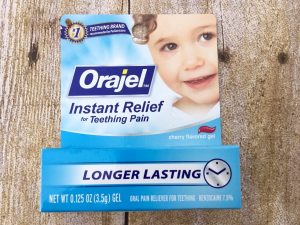 For many years, brands like Orajel, Anbesol, Orabase, and Topex were household names for anyone with an infant. Manufacturers spent billions of dollars marketing these products as safe methods of soothing teething pain. Yet lurking beneath the wholesome images of happy babies and grateful mothers was a hidden danger.
For many years, brands like Orajel, Anbesol, Orabase, and Topex were household names for anyone with an infant. Manufacturers spent billions of dollars marketing these products as safe methods of soothing teething pain. Yet lurking beneath the wholesome images of happy babies and grateful mothers was a hidden danger.
In 1961, Del Laboratories acquired a small company that had created a topical anesthetic that could be used for tooth pain and mouth sores. They launched that product, Orajel, into the national market. Thanks to a dynamic marketing campaign, Orajel became the Number 1 oral analgesic in the nation
In 1971, the U.S. Food and Drug Administration began receiving adverse event reports from both adults and children who used benzocaine-based products. In the early 2000s, the agency received 119 reports of adverse events involving benzocaine, 30 of which involved the drug being used for tooth and mouth pain.
A disturbing trend among those reports was a condition called methemoglobinemia, a condition that affects the blood’s hemoglobin, which is responsible for transporting oxygen. The results can range from shortness of breath, headaches, dizziness, seizures, and heart arrhythmias to cyanosis and death.
Scientists discovered that, when benzocaine metabolizes, it can alter the composition of iron in the body’s hemoglobin. When this happens, giving the patient oxygen doesn’t help because hemoglobin is rendered useless. The only way to treat this condition is to administer a medication called methylene blue to counteract the effects of methemoglobinemia.
Evidence that benzocaine could put infants at risk continued to accumulate. European countries began labeling Orajel and other benzocaine-based products as unsafe for children under 12. In 2011, the U.S. FDA issued a statement warning consumers of a “rare but serious” condition that could result from using benzocaine as an oral analgesic.
Symptoms of methemoglobinemia in infants include pale, gray or blue colored skin, lips, and nail beds; shortness of breath; fatigue; confusion; headache; lightheadedness; and rapid heart rate. The only way to determine if a child is suffering from methemoglobinemia is to conduct a blood gas test before the condition becomes fatal. After death, it is nearly impossible to detect.
Many experts believe that a significant percentage of infant deaths has been attributed to (sudden infant death syndrome (SIDS), when in fact, the child has died due to benzocaine-induced methemoglobinemia.
In 2018, Church & Dwight Co., Inc., the makers of Arm & Hammer products, acquired Del Pharmaceuticals from Coty, Inc. Church & Dwight issued a press release excitedly announcing the move April 1, 2018, naming Orajel as its most profitable product.
Less than two months later, the FDA clamped down on Orajel and other benzocaine-based products made for use in infants, demanding that companies stop marketing the products for use in children under two years of age, and adding warning labels outlining the risks.
Today, benzocaine-based products are still on the market. Orajel has developed a non-benzocaine-based teething pain reliever, but its benzocaine products are still available. Some discontinued benzocaine-based oral analgesics for babies are still available on secondary resale sites like ebay and Mercari, despite the risks.
Though there is no longer a picture of a baby on the label of Orajel and other big-brand benzocaine products, many consumers don’t realize the danger. Some parents still reach for benzocaine-based gels and creams not recognizing that products they grew up with can harm their child. Some off-brand oral analgesics containing benzocaine may feature misleading labels or pictures that confuse the issue more.
The bottom line is that benzocaine-based oral analgesics should not be used for children under two years old.
The FDA has also repeated a previous warning to avoid homeopathic teething products, which may have a variety of possible side effects.
The American Academy of Pediatrics does not recommend teething creams because they do not remain in the child’s mouth. Instead, the academy recommends teething rings or massaging infants’ gums to relieve pain.












